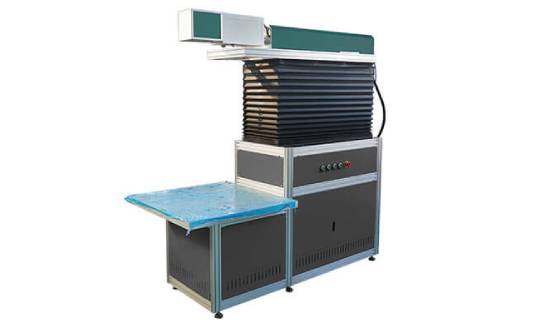+86 132 5674 2787
Máquina de corte por láser de metal, Máquina de corte por láser de fibra, Proveedor de máquinas de corte por láser, Máquina de marcado láser, Máquina de marcado láser de fibra...

Noticias de tecnología
Casa >> Blog >> Noticias de tecnología
1. The birth of 3D laser marking machine
3D laser marking is a laser surface sag processing method. Compared with traditional 2D laser marking, the surface flatness requirements of 3D marking have been greatly reduced, the processing effect is more colorful and more creative The processing technology came into being. 3D laser marking technology is booming and has received a lot of attention in the industry. Some forward-looking industry companies are also stepping up the research and development of 3D laser marking products; in the next few years, laser marking will surely gradually change from 2D The transition to 3D, 3D laser marking will surely penetrate into all areas of people's lives.
Second, the principle of 3D laser marking
The high energy density laser is used to locally irradiate the workpiece to vaporize or chemically change the color of the surface material, thereby leaving a permanent mark. Laser marking can mark all kinds of text, symbols, and patterns, and the character size can even reach the micron level. The laser beam used for laser marking is generated by the laser, after a series of optical transmission and processing, the beam is finally focused through the optical lens, and then the focused high-energy beam is deflected to the designated position on the surface of the object to be processed, forming a permanent recess trace. The traditional 2D laser marking adopts the back-focusing method, and generally can only perform plane marking within a specified range. The advent of a professional laser marking machine solves the long-standing inherent defect of 2D laser marking machine. 3D laser marking machine adopts advanced front gathering method, and there is more dynamic focusing seat Principles, like the working principle of candle-like imaging, through software control and moving dynamic focusing mirror, variable beam expansion is performed before the laser is focused, in order to change the focal length of the laser beam to achieve accurate surface focusing processing of different objects.

3d Laser Marking Machine
3. Application of 3D laser marking industry
1. Large-scale marking
3D marking adopts the front focusing optical mode, using larger X, Y-axis deflection lenses, so it can allow a larger transmitted laser spot, better focusing accuracy, and better energy effect; When working with the same focusing accuracy, the marking range can be larger.
As long as the shape of the workpiece is set in advance, only the setting can be switched to correspond to the focal length, marking position, and shape change of different product positions. No need to move the workpiece multiple times or laser marking to complete.
2. Deep engraving
The traditional 2D marking for deep carving on the surface of the object has inherent defects. As the laser focus moves upward during the carving process, the laser energy on the actual surface of the object will drop sharply, which seriously affects the effect and efficiency of deep carving. The traditional deep carving method is to move the lifting table to a certain height every certain time during the engraving process by the electric method to ensure good focusing of the laser surface.
3. High and low surface marking
In the current traditional 2D marking mode, the workpiece must be placed on the same plane, and the processing surface must also be on the same plane, in order to achieve the marking of a molding. Using the characteristics of the 3D laser marking machine, it can realize the marking of one-time forming under the condition that the workpiece has a height drop, even on the inclined slope, it can maintain the consistency of the processing so that the processing content is not deformed and no color difference is formed. It greatly facilitates the carving of the three-dimensional structure of the workpiece, reduces the process of the process, and improves the efficiency of marking.
4. Marking on any surface
Because 3D marking can quickly change the laser focal length and laser beam position, it is possible to mark curved surfaces that were not possible with 2D in the past. After using 3D, the cylindrical marking within a certain arc can be completed at one time, which greatly improves the processing efficiency. Furthermore, in real life, the surface shape of many parts is irregular, and the surface height of some parts is quite different. It is really helpless for 2D marking processing. At this time, the advantages of 3D marking will become more obvious.
5. Color engraving and printing
In the same plane, it can achieve black and white, and even multi-color marking, the effect is more abundant. For the blackening of general metal surfaces, such as anodized aluminum, usually higher frequency pulses are used under appropriate energy, and marking is performed under certain defocusing conditions. The defocusing distance obviously affects the energy distribution of the laser on the material surface and Color effect. For general 2D marking users, even if advanced features such as surface marks are not required, it is meaningful for the 3D marking machine to perform multi-gray and multi-color plane processing.
4. Overview of 3D laser marking
3d laser marking machine supplier believes that: 3D Laser Marking Machine supplier can perfectly realize the precise processing of any curved surface workpiece without defocusing; it can also track the depth of the engraving focus in real-time so that the processing efficiency and The quality is better than the traditional 2D marking machine. It is suitable for marking and deep carving of any metal (including rare metals), engineering plastics, electroplating materials, coating materials, spraying materials, plastic rubber, epoxy resin and other materials.